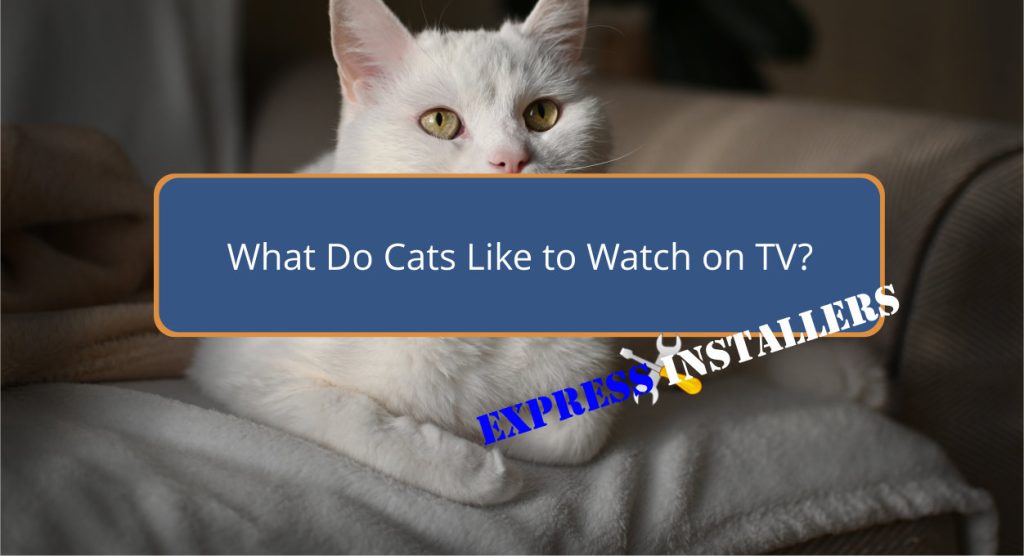
Cats prefer TV programs showcasing quick movements and familiar sounds. They love bird videos with rapid wing flapping and chirping, attracting their pawing instincts.
Rodent videos mimic hunting scenarios, keeping them engaged. Fish videos‘ vibrant colours and fluid movements stimulate their predatory behaviour.
Squirrel antics and unpredictable movements fascinate and amuse them. Cat-specific games like mouse catching and string chasing provide mental stimulation and satisfy hunting instincts, which are 8-Houressential for their well-being, especially indoors.
Discovering which visuals and sounds captivate your feline friend can enhance their viewing experience even more.
Bird videos captivate cats due to the dynamic movements and sounds of flying and chirping birds. When your cat watches these videos, they’re visually stimulated by the rapid flapping of wings and the unpredictable flight patterns. The chirping sounds further engage their auditory senses.
You’ll often notice your cat pawing at the screen, trying to interact with these virtual birds. Longer videos featuring a variety of bird species can keep your cat’s attention for extended periods, providing sustained mental engagement. These videos mimic natural prey behaviours, addressing your cat’s instinctual hunting drives.
Observing your cat’s reactions can give insights into their predatory instincts and preferences, highlighting how visual and auditory stimuli from bird videos can be fascinating for them.
As bird videos captivate your cat with their dynamic movements and sounds, rodent videos featuring mice are equally enthralling due to the cats’ natural prey instincts.
Cats are drawn to seeing mice emerging from mouseholes to eat, mimicking real-life hunting scenarios. These videos can last up to 8 hours, providing extended engagement periods for your feline.
In some videos, the interaction between mice and birds further heightens their interest, combining two of their favourite prey types. By stimulating their predatory behaviour, rodent videos serve as an enriching and entertaining activity.
Observationally, the prolonged attention cats give to these videos underscores their effectiveness in attracting and holding your pet’s focus.
Fish videos captivate cats through their vibrant colours and fluid movements, which closely mimic the behaviour of natural fish and engage their predatory instincts. These videos provide essential visual stimulation, keeping your cat entertained and mentally sharp. The fish’s bright hues and darting motions are particularly effective in holding their attention.
Watching fish videos can be beneficial, especially when you’re not home. The interactive elements, like fish swimming across the screen, can help maintain your cat’s interest and activity levels.
| Feature | Benefit | Observation |
|---|---|---|
| Vibrant Colors | Visual Stimulation | Cats remain fixated on the screen. |
| Fluid Movements | Engages Hunting Instincts | Mimics are natural prey, boosting interest. |
| Interactive Elements | Keeps Cats Active | Prolong engagement and focus. |
Squirrel videos offer an engaging spectacle for cats, as they showcase these small mammals’ dynamic behaviors and playful antics. Cats enjoy watching squirrels in action, whether playing or searching for food. The movement and unpredictability of squirrels can fascinate a cat’s attention, making these videos a source of visual stimulation and amusement.
Specific interactions like peek-a-boo scenes further involve cats, holding their interest longer. Additionally, when squirrels are featured alongside birds, the diversity in movement and behaviour provides an even more enthralling viewing experience. These videos fulfil a cat’s natural curiosity and hunting instincts, offering an enriching activity that keeps them entertained and mentally stimulated.
Video cat games, such as mouse catching and string chasing, provide substantial mental stimulation and entertainment for your feline companion. Observational studies show that these activities can satisfy a cat’s natural hunting instincts, keeping them engaged and active indoors.
Popular cat games on video include:
These videos help maintain your cat’s physical and mental well-being, especially when outdoor access is limited.
Abstract footage featuring psychedelic swirls and calming soundtracks aims to create a soothing environment that helps cats relax and unwind. These videos aren’t meant for entertainment but focus on relaxation and stress relief.
Cats might find the abstract footage soothing, which can aid their sleep. The swirling patterns and gentle sounds create a calming ambience that can benefit your feline‘s mental well-being.
Observations indicate that abstract footage’s visual and auditory elements can reduce anxiety levels in cats, making it a valuable tool for creating a peaceful home environment. These videos provide a tranquil sensory experience and help maintain your cat’s overall emotional health, particularly in stressful situations.
You should play videos featuring prey animals like birds, mice, and fish. These videos, with quick movements and high-pitched sounds, effectively stimulate a cat’s natural hunting instincts and capture its attention.
Your cat would likely enjoy TV programs featuring prey animals like birds or fish. Opt for videos with quick movements, high-pitched sounds, and bright colours. Interactive content can also keep your cat engaged and entertained.
You’ll observe that cats perceive TV images in shades of grey and blue, focusing on movement. They mistake these images for natural objects, triggering their predatory instincts and curiosity, leading them to chase or interact with the screen.
Yes, cats do get entertained by TV, especially by moving images and sounds that mimic prey. However, their interest varies, and many cats prefer watching real-world activities like birds outside, stimulating their instincts more effectively.
You’ve seen that cats are captivated by bird videos, rodent clips, fish swimming, and squirrels darting about. They also enjoy interactive cat games and abstract footage.
Understanding their preferences will help you tailor their viewing experience to keep them mentally stimulated and entertained. Observing your cat’s reactions will also help you fine-tune what they enjoy most.
So, switch on the TV, and let your feline friend indulge in their favourite visual delights!
Mon-Fri: 24 Hours
Sat: 24 Hours
Sun: 24 Hours